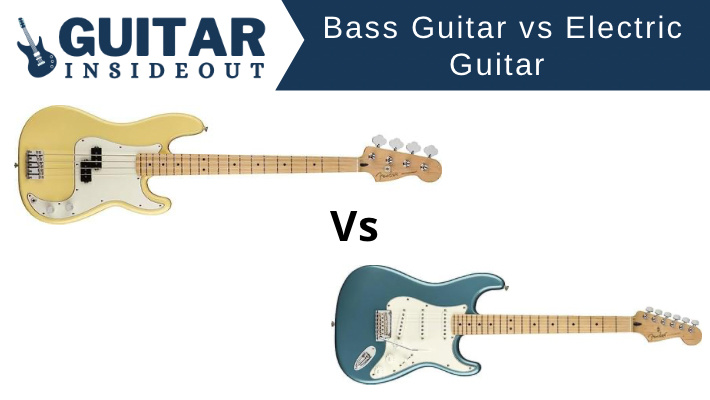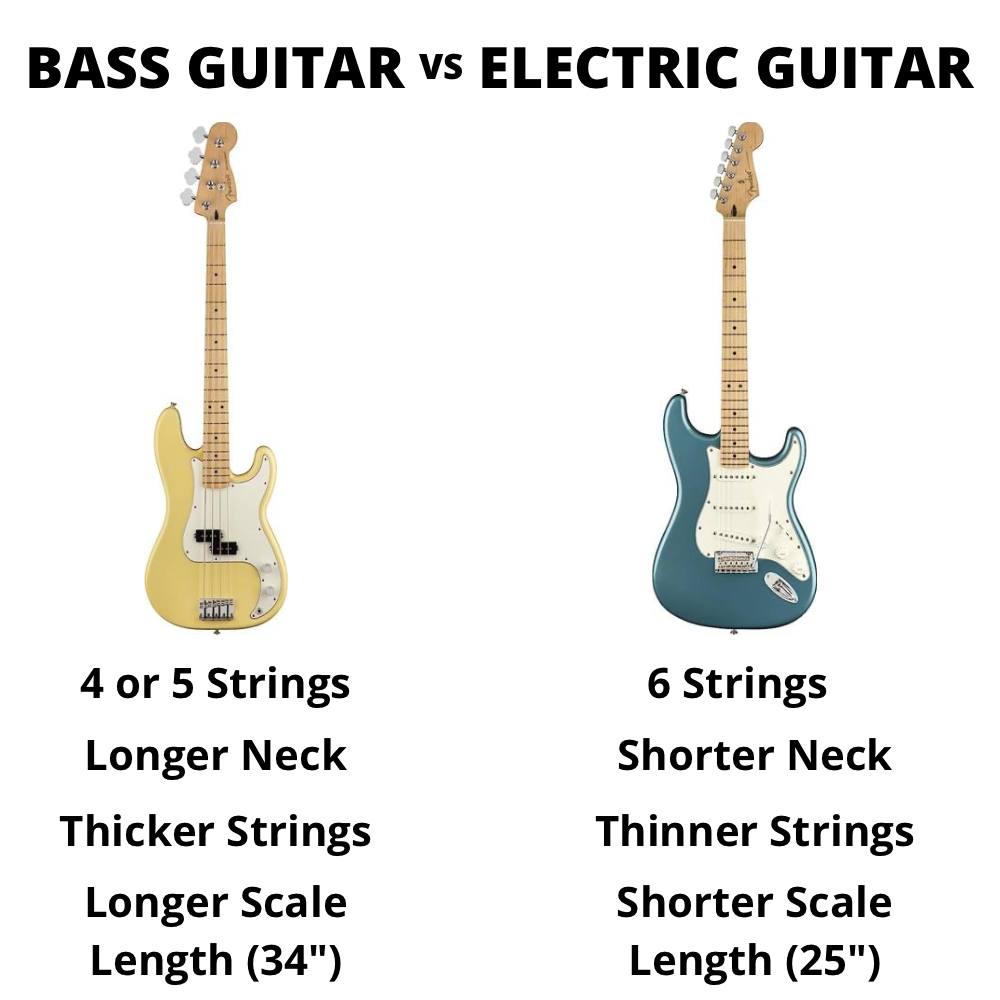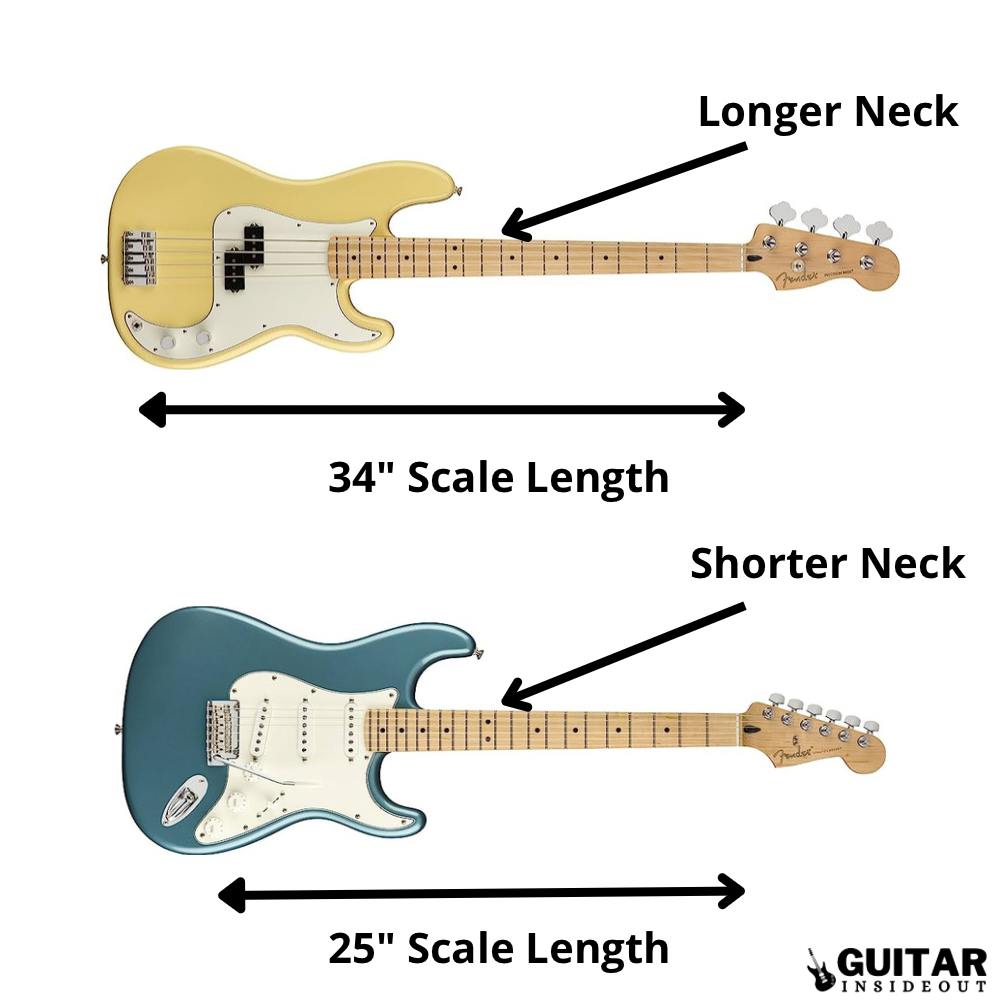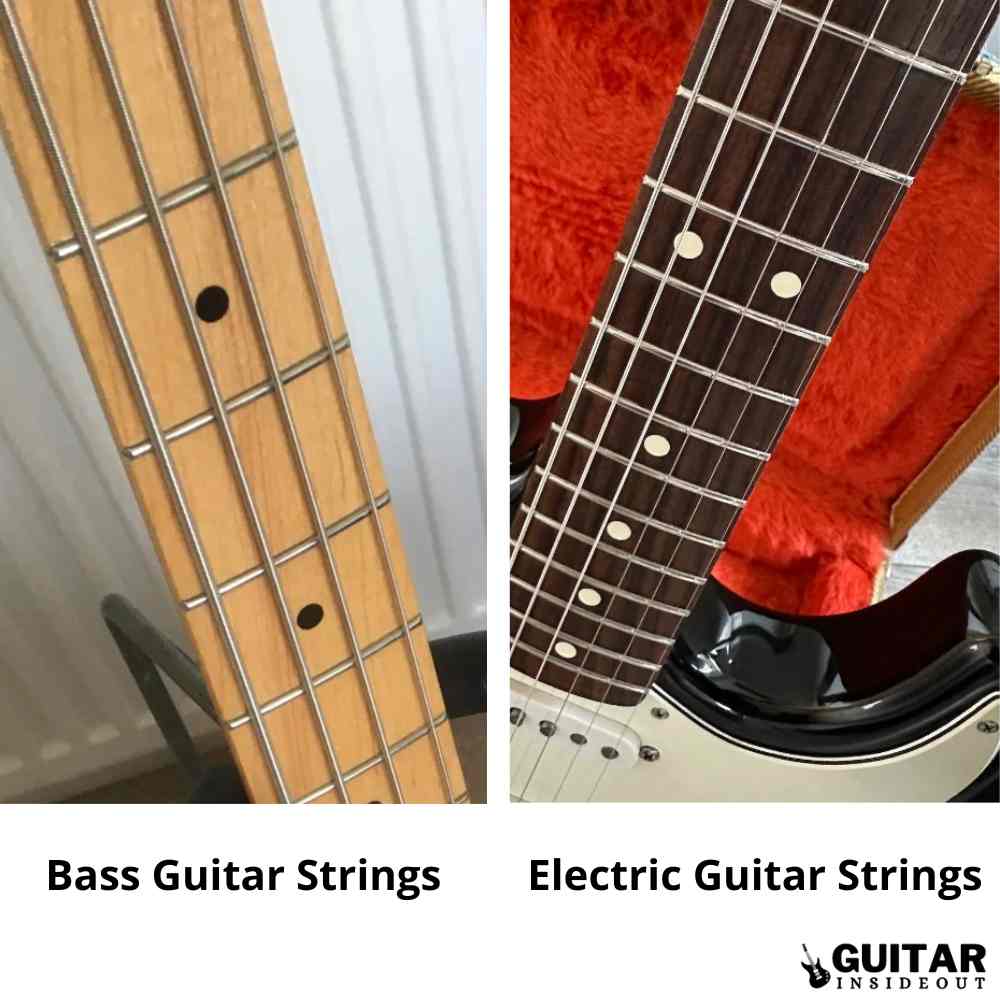Bass guitar and electric guitar are both great instruments. They contribute so much to the sound and feel of many musical genres and styles.
But you might be unsure of what the key differences are between the two guitars. Especially if you’re considering learning to play one.

The way they look, are made, play and sound are very different. And one might be more suited to you depending on the style of music you like, ease of learning and your budget (amongst a lot more).
So whether you’re a budding musician seeking guidance on your instrument of choice or simply looking to explore these two hugely popular guitars, this guide will give you a comprehensive understanding of the differences between bass guitars and electric guitars.
The Main Differences Between Bass Guitar vs Electric Guitar
- Bass guitars are typically larger and thicker while electric guitars are often slimmer and more compact.
- Bass guitars usually have four strings (E-A-D-G) whereas electric guitars typically have six strings (E-A-D-G-B-E). You do get 5 string basses and 7, 8 and more string electric guitars but they are not typical.
- Bass guitars have thicker strings compared to electric guitars.
- Bass guitars generally have a longer scale length compared to electric guitars along with a longer and wider neck to accommodate the greater scale length and thicker strings.
- Bass guitars produce deep, resonant tones that establish the low-end presence. Electric guitars offer a versatile range of tones, from clean to distorted, thanks largely to the different pickups, amplifiers and effects that are used with them.
- Bass guitars are crucial in providing the rhythm and groove to music. Electric guitars are usually more melodic and harmonic and often the focus or spotlight of the music.
- Bass guitar techniques often involve fingerstyle, slap and pop and playing with a pick. Electric guitar techniques are mainly strumming and picking but also legato, bending, soloing etc.

The Basics of Bass Guitar and Electric Guitar
Let’s take a quick look at the basics of how both the bass and electric guitar work and act. This will help us to compare them and look at their differences fully.
Bass Guitar
The bass guitar is a fundamental part of most types of music. It provides the low-end and rhythm in a band.
These are the basics you need to know about the bass guitar:
Number of Strings: Bass guitars usually have four strings but they can range from four to six strings. The four string configuration is the most common though and offers a balanced and versatile range.
Tuning: Bass guitars are tuned an octave lower than the standard tuning of an electric guitar. The standard tuning for a four-string bass guitar is E-A-D-G, starting from the thickest string. The lower tuning produces deep and resonant tones that are felt as much as they are heard.
Scale Length: Bass guitars mostly have a longer scale length than electric guitars. Part of the characteristic tone of a bass comes from that longer scale length. It also affects the spacing between frets, making them bigger than on an electric guitar.
Role in a Band: The bass guitar is essential to the overall sound of a band. It locks in with the drummer and provides the foundation and rhythm for the songs. On top of that it’s deep tones and rhythmic patterns are important as part of the dynamics and energy of the music.

Electric Guitar
The electric guitar may be slightly less important than the bass but its usually more noticeable in music and has a versatility and range of sounds that very few instruments can compete with.
These are the basics about the electric guitar:
Number of Strings: Electric guitars typically have six strings. Seven-string and twelve-string guitars are also available but they are far less common than the six string.
Tuning: Electric guitars standard tuning is E-A-D-G-B-E, starting from the thickest string.
Scale Length: Electric guitars come in various scale lengths with 25.5″ being the most usual. However this is much shorter than bass guitars standard scale length of 34″.
Body and Design: Electric guitars come in various body shapes and designs. The solid-body is the most common but there are also semi-hollow and hollow-body electric guitars. Solid-body’s are the most popular and versatile and work well in most styles of music. Semi-hollow and hollow-body guitars have a more resonant and acoustic-like tone which makes them more suitable for genres like jazz, blues, and certain types of rock.
The Anatomy
The anatomy of the two types of guitars is one of the main areas to look at when comparing them. The design and the components that make up each instrument influences how they sound and play.
Electric guitars and bass guitars share some obvious features of their anatomy. They both have a body, neck, fretboard and strings. But there are some crucial distinctions that set them apart.
Body
The body of a bass guitar is usually thicker and larger than an electric guitar. Electric guitars slender and compact body make them easier to move with and play but the larger body of the bass contributes to its deeper tone.
Neck
The neck on each guitar is another key difference. Basses generally have wider and longer necks that accommodate the thicker strings they use and longer scale length.
Electric guitars have narrower necks. This makes navigating the fretboard and playing more complex and intricate music easier.
Fretboard
The fretboard itself is quite different in the two instruments. Bass guitars usually have wider fretboards that suits some of the techniques used when playing them, like slapping and popping. Like their necks electric guitars have narrower fretboards too.
These differences impact on how each guitar sounds. The size and shape of the body, neck and fretboard all play a role in the tone you get from them.
Strings
The type and number of strings is a major difference between bass guitars and electric guitars. The configuration of strings and how they work is key to understanding the playing techniques and musical styles associated with each instrument.
Bass guitars traditionally have four strings, commonly tuned to E-A-D-G, starting from the lowest pitched string. The simplicity of having only four strings allows bass players to focus on establishing the groove and locking in with the rhythm section of a band.
Electric guitars however typically have six strings, tuned to E-A-D-G-B-E, starting from the thickest string. Having 6 strings let’s you play a bigger range of notes and chords.

The differences in string configurations have a direct impact on the techniques used to play and musical styles associated with each instrument.
Bass players often use techniques such as fingerstyle, where you pluck the strings with your fingers rather than using a pick, and slap and pop, a percussive technique that adds rhythmic flair.
6 strings on electric guitars mean you have the opportunity to play using various techniques. Strumming and picking are the two most used but there’s also bending, vibrato, sliding etc. These techniques help to make the guitar versatile and commonplace as the focal point in lots of genres of music.
So the string configuration plays a big role in what both the electric and bass guitar is capable of and the techniques you need to fully unlock their potential.
Playing Techniques
The playing techniques for bass guitars and electric guitars are a big part of how they sound and how you achieve certain styles.
Bass Guitar Techniques
Bass players will use a variety of techniques to get the sound they want from their guitar. These are the most well known techniques used on the bass guitar:
Fingerstyle: The most common technique used by bass players is simply plucking the strings with the fingers. Most players use the index and middle fingers or a combination of fingers. Fingerstyle is popular because it gives you precision and control, enabling bassists to be consistent and smooth in their playing.
An example of bass fingerstyle:
Slap and Pop: This technique involves hitting the strings with thumb (slap) and plucking or pulling the strips with the fingers (pop). Slap and pop is associated with genres like R&B, funk and slap bass-driven styles as it adds percussive, funky and distinctive sound.
The below video is a good example of slap and pop:
Playing with a Pick: Like an electric guitar using a pick to pluck the strings is fairly common. With bass it produces a more aggressive and defined attack helping the bass to cut through a dense mix. This is why playing with a pick is often see in rock, punk and metal amongst others.
Electric Guitar Techniques
The electric guitar also has many techniques that are specific to it. These are a few of the fundamental techniques associated with playing the electric guitar:
Strumming: The most basic but also fundamental technique for playing the guitar. Strumming is when you sweep the pick or fingers across the strings. It’s mostly used for rhythm guitar parts and makes a full sound.
Picking: as the name suggests picking is when you pick or pluck each string individually. Single note picking is generally used for lead guitar work. There are various different types of picking techniques like hybrid and travis picking that sound different.
Bending: Bending is when you push or pull the string and alter it’s pitch. Bending adds a different feel to your playing and is a big part of certain types of music: blues uses lots of bends and guitars solos often feature lots of bending.
Legato: legato is also used by bassists but is far more common when playing electric guitar. It refers to things like hammer ons and pulls offs, which reduce the amount of picking you need, and a smooth transition from note to note.
These are just a few examples of the techniques used by by bass and electric guitarists. While they share some techniques and they are transferable between the two there are many that are specific to each instrument.
How They Sound
Unsurprisingly bass guitars and electric guitars sound very different. That comes from the nature of their role in music – bass being low and deep, for example – but also the pickups, amplifiers and effects that are involved will contribute to their overall sound.
Bass
- Low-End Emphasis: The bass guitar is known for its deep, resonant tones that emphasize the lower frequencies. Bass lines are often referred to as having a ‘rumbling’ sound. The bass acts as a foundation for the music.
- Styles: Depending on how it’s played a bass guitar can sound mellow and subdued or aggressive and growling.
- Pickup Configuration: Bass guitars often feature one or multiple pickups. These pickups are typically placed near the neck or in the middle of the guitar. The pickups are specifically designed to capture the low frequencies which results in a warm and rounded tone.
- Tone: While the bass guitar mainly emphasizes the low frequencies it still has a wide range of tones. It doesn’t have to only be repetitive single note bass lines. Skilled bassists can create a variety of tones by using a variety of playing techniques. Plucking closer to the bridge gives a brighter tone and slapping and popping will add percussive elements, as two of many examples.
Electric Guitar
- Versatility: Electric guitars are much more versatile than basses. They have a wider range of tones and can produce a lots of different styles of music.
- Sound: You can use different amplifiers and effects pedals with electric guitars to get an even greater array of sounds. Electric guitars can go from clean and soft to distorted and aggressive, allowing them to be used in various music genres.
- High-End: Electric guitars are good at the higher frequencies of sound, producing bright and cutting tones. This vibrant and articulate sound is what makes the electric guitar the choice for solos and lead melodies.
- Playing Styles: Electric guitars can be played in different ways. You can delicately fingerpick them through to strumming with lots of power. The sound reflects the way in which they are played.
- Pickups: Electric guitars almost always feature either two or three pickups. These are either single-coil, P90 or humbucker pickups and come in various configurations. Single-coil pickups produce a bright and crisp sound, humbuckers provide a thicker and warmer tone with reduced noise and P90’s are somewhere in between the two.
Role in Music
Bass and electric guitars have very different functions within a band or piece of music. Depending on the genre they also play very different parts.
As mentioned earlier the bass guitar serves as the sort rhythmic foundation of a band. Along with the drums it makes up the rhythm section and together they keep the band or rest of musicians tightly connected. It’s the backbone for the rest of the music and drives it forward.
In some genres like as reggae, funk and jazz the bass guitar takes on a more prominent role in driving the rhythmic pocket. This gives the other instruments the chance to build on the foundation the bass has created.
The electric guitar is a very different beast. It takes on a role of melody and harmony and is often center stage. It will have a much more prominent place within the music and usually captures the listeners attention. This could be through catchy or memorable riffs, intricate melodies or impressive solos.
You see in genres like rock, blues and metal the guitar is front and center and creates the licks and riffs you remember most or the solos that really stand out. It’s the lead instrument.
However, it’s worth noting that these roles are not fixed. Bass guitars and electric guitars can interchange and carry out different musical function depending on what is needed or wanted.
Both guitars compliment each other exceptionally well and are made for working together. They’re a great match and it’s why you see so many bands with guitar, bass and drums. It’s the classic lineup that simply works.
Choosing the Right Instrument for You
Choosing between guitar and bass can be difficult. Especially if you weren’t sure of the differences between the two (hopefully from reading this you now do!)
But if you’re still struggling to make a decision consider these few factors:
Musical Preferences
Take some time to think about the music genres you are most drawn to. What is it that you like about them?
Is it the riffs, solos or melodies? If so electric guitar might be for you.
If it’s the rhythm and groove of music then bass will probably be a better fit.
Musical Goals
Do you want to be part of a band? Play live and even recording? Or are you more drawn to being a solo act?
Do you see yourself as a session musician? Or are you purely a bedroom player doing it for fun?
The goals you have will help you to make a final decision.
Comfort and Playability
Feeling comfortable as you play is essential. So you need to choose an instrument that suits you physically.
Consider things like the size, weight and scale length. Get to music stores and try out different basses and electric guitars. See how they feel, whether you are comfortable standing with them, the size of the frets and string spacing etc.
Portability
If you’re planning to travel with your guitar then side and weight are important. Bass guitars are usually heavier and larger than electrics. So if you don’t have a lot of space for storage or will be travelling a lot an electric guitar might be a better option.
Ease of Learning
Neither instrument is easy to learn but as we will talk about in more depth later some beginners find bass simpler at first. The focus on rhythm and the easier playing technique arguably make it more suited to novices.
Budget
Have a clear idea of what your budget is. Electric guitars and bass guitars come in a wide range of prices.
If you’re a beginner there are many affordable instruments aimed at those just starting out. And if you’ve played for a while there are lots of higher end guitars.
Also consider the brand and the features you want on your guitar. Obviously the more you want the more it will cost.
Do Research
It’s always best to do some research before buying a guitar. Read reviews, watch some demos, listen to it being played etc.
Becoming as familiar with as many guitars as you can will help you to narrow down your choices.
Seek Guidance
It’s never a bad idea to reach out to those with more knowledge than you. So consult any experienced musicians or guitars teachers you know.
Don’t be afraid to ask those working at music stores as well. They will be able to provide some valuable insights and recommendations based on what they know.
Which is Easier to Play?
Bass guitar. (Sorry bassists!)
If I’m honest it’s not quite as straightforward as that. But the reality is that at the start a lot of simple songs have very easy bass lines.
These will be single note, single string parts that can be picked up relatively quickly compared to the basics of electric guitar. Strumming an electric guitar, for example, is generally a trickier technique to learn.
But when you get to the physical elements of each guitar things are different.
Electric guitars have shorter necks, which make both handling and playing them easier. They are lighter in weight so can be held with less effort. They also have thinner strings with less tension in them which makes holding them down easier too.
Now don’t get me wrong – the beginning stages of learning either guitar is tough. It will feel awkward and you will have painful fingers with sore fingertips from pressing the strings down on both electric and bass guitar (until you’ve developed calluses that is).
But in those first few weeks the smaller neck and thinner strings will almost certainly feel easier and be less painful on your fingers.
It’s once you get into the more advanced stages of learning that you’ll find bass is just as difficult or even more so than electric guitar. There are some ridiculously difficult bass parts in all genres of music.
So the honest answer is both instruments will feel hard at first. The electric guitar will probably be less hard on your fingers and be more comfortable to hold but the actual techniques that get you playing songs will be tougher. After that there’s very little in it.
Is it Difficult to Switch Between Bass Guitar and Electric Guitar?
While both instruments are guitars and generally similar it will feel different switching back and forth.
The differences we’ve been through in this article – the number of strings, neck length, string thickness, playing techniques etc. – means you will have to change the way you play on each.
But if you’ve started with guitar then switching to or playing bass shouldn’t prove too demanding. Especially if you play with a pick, as you would on electric guitar. Most of the fundamentals are the same.
Going from bass to electric guitar will be more of a challenge. You won’t be used to strumming or forming chords. But having experience with a stringed instrument will certainly put you in a better position than if you were starting from scratch.
Either way you shouldn’t be put off from trying one or the other.
Before you go…
For more information about choosing and a guitar and learning try these articles:
How Long Does it Take to Learn Guitar? A Realistic Guide
How to Choose Which Size Guitar you Should Get: The Ultimate Guide
Related Articles